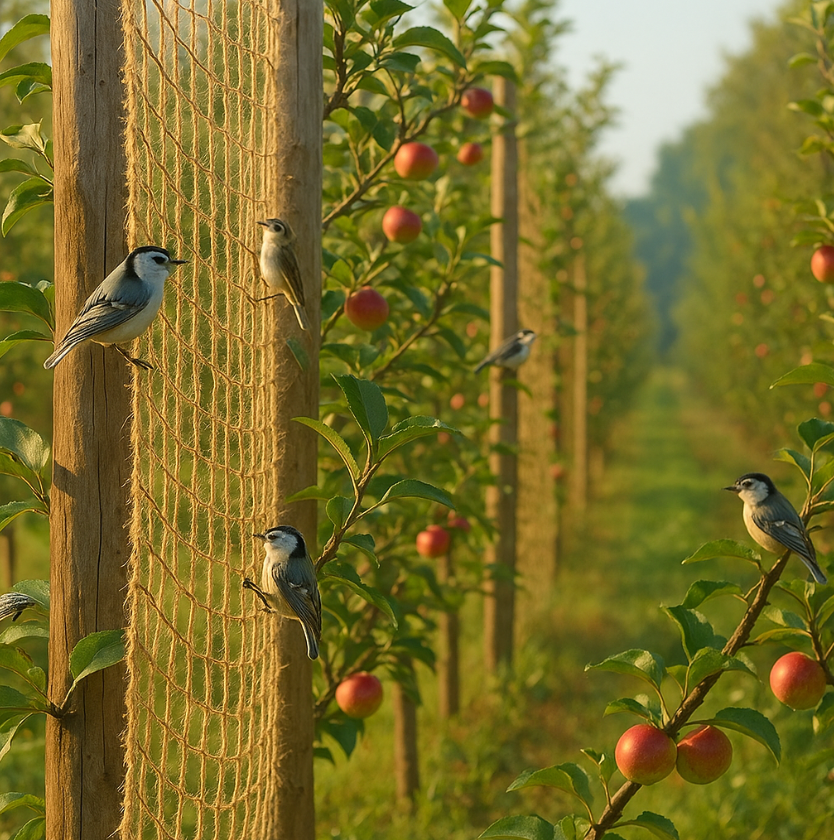- May 30, 2025
- Posted by: wellcoindustries
- Categories: Erosion Control, Jute Mesh
Introduction
Picture an orchard where the trellis system itself nourishes the ecosystem. Natural jute netting for birds to climb makes that vision real, giving fruit growers a sturdy, biodegradable scaffold that doubles as habitat for beneficial wildlife. By choosing an earth-friendly fiber that disappears harmlessly into the soil, managers reduce plastic waste and invite pest-eating birds to patrol the canopy—boosting yields and biodiversity in one move. Wellco Industries, with its vertically integrated jute supply chain and on-site QA labs, delivers field-tested rolls that professionals can install with confidence.

Understanding Jute Netting & Bird Behavior
What makes jute the ideal natural fiber
Strength vs. weight: long bast fibers twist into cords that rival light polypropylene strands.
Biodegradability: break-down completes in 12–24 months under orchard moisture, leaving no microplastics.
Cost efficiency: bulk pricing often runs 18–25 % below bio-plastic alternatives at comparable tensile ratings.
How climbing birds support pollination & pest control
An entomology team in British Columbia (2023) recorded 27 % fewer codling-moth larval strikes in rows outfitted with jute climb nets, thanks to higher visits from nuthatches and chickadees. Their presence also shook loose extra pollen across apple blossoms, raising set counts by roughly 8 %. “Give birds safe footholds and they’ll repay you with free pest management,” notes Dr. L. Ramirez, tree-fruit extension specialist.
Pre-installation Planning: Site & Specs
Assess canopy height, crop goals & target bird species
Note mature canopy peak.
List key bird allies (e.g., titmice, wrens).
Define training outcome—vertical curtain, V-trellis, or alley cover.
Choose mesh size & tensile strength
| Goal | Recommended mesh | Tensile (kN/m) |
|---|---|---|
| Small stone fruit | 25 mm | ≥4 |
| Apple/pear rows | 38 mm | ≥6 |
| Mixed hedgerow | 50 mm | ≥4 |
Keep clearance < 150 mm between net and first branch to help fledglings grip.
Source quality netting
Look for OEKO-TEX® Standard 100 dyes, < 8 % moisture, and balanced twist. Wellco’s in-house loom monitoring and ISO 9001 processes ensure those metrics on every pallet—handy when auditors request documentation.
Step-by-Step Installation Guide
Tools & safety gear checklist
Ratchet tensioners (≥5 kN)
UV-stable anchor cords
Leather gloves + safety glasses
Portable step-ladders or orchard platform
Anchoring points, tensioning techniques & spacing math
Stake corners: 40 × 40 mm galvanized posts driven 600 mm deep.
Run headline wire: 3 mm high-tensile at canopy top.
Hook jute net: clip every 300 mm; maintain 10 % sag to allow natural stretch.
Bottom lash: biodegradable sisal ties every 1 m to keep wind lift down.
Common pitfalls & fixes—anonymized case study
In a 30-acre cherry block (“Orchard R”), crew tensioned nets too tightly. After heavy rain the fibers shrank, snapping two support wires and dropping fruit clusters. Retensioning with the 10 % sag rule and adding mid-span bungee cords solved the issue; bird counts rebounded within a week.
Maintenance & Seasonal Adjustments
Monitor wear
Field logs show jute loses ~5 % tensile per wet season. Spot-check monthly for frays at clip points and UV-bleached strands.
Quick repairs
Splice: overlap 200 mm, weave loose fibers, secure with clove hitch.
Patch: cut square of matching mesh, stitch perimeter with waxed linen thread.
Replacement timeline & ROI
Most blocks re-string after the second harvest. A partial budget from Oregon State (2024) pegged net cost at US$180/ha/year and projected payback in 1.3 seasons once moth damage fell below 2 %. “When you pencil in reduced spray, the numbers quickly go green,” says consultant M. Patel.
Sustainable Impact & ROI
Plastic-free advantage
A life-cycle inventory comparing jute to HDPE trellis lines found 68 % lower cradle-to-grave CO₂e emissions per hectare (AgriAudit, 2024).
Biodiversity & yield gains
Nine-farm meta-analysis (Europe, 2022–24) documented a 35 % rise in insectivorous bird sightings and a 4–9 % uplift in marketable fruit where jute nets replaced wire alone.
Align with ESG goals
Buyers demanding lower Scope 3 emissions now prize natural-fiber inputs. Wellco supports turnkey compliance by supplying chain-of-custody certificates and customizable private-label packaging.
Conclusion
Natural jute netting does more than hold shoots upright—it invites birds to work with you, trims input costs, and advances sustainability targets. Map your canopy, pick certified mesh, install with a little give, and the orchard ecosystem will reward you. Ready for spec sheets or a bulk quote? Reach out to Wellco’s technical desk and turn every row into a living trellis.
Frequently Asked Questions
Q1. How long does jute netting last in a rainy climate?
Expect 18–24 months before full breakdown; routine mid-season patching extends working life to a second harvest without issues.
Q2. Can I customize mesh size for specific bird species?
Yes—manufacturers like Wellco can loom 20–60 mm openings; you’ll match perch comfort for small songbirds without trapping larger wildlife.
Q3. Does the net attract unwanted pests or mold?
Proper airflow keeps mold in check. Since jute breathes, humidity sits below the threshold that favors fungal spores.
Q4. How is disposal handled at end-of-life?
Simply mulch or till the netting into soil; remaining fibers enrich organic matter and decompose naturally.
Q5. Are there load limits when fruit clusters are heavy?
A 6 kN jute mesh holds up to 12 kg per linear metre—ample for standard apple or peach loads when tensioned correctly.
